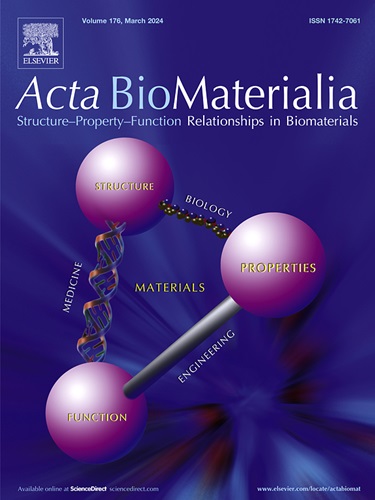Rapid synthesis of degradable ester/thioether monomers and their incorporation into thermoset polyurethane foams for traumatic wound healing
IF 9.4
1区 医学
Q1 ENGINEERING, BIOMEDICAL
引用次数: 0
Abstract
Polyurethane (PUr) foam hemostatic dressings are highly effective at controlling bleeding in traumatic wounds, but their traditionally slow degradation rate requires dressing removal, which could result in wound rebleeding. Incorporating degradable linkages into the PUr network can provide a biodegradable dressing that could be left in place during healing, eliminating rebleeding upon removal and providing scaffolding for new tissue ingrowth with no remains of the applied dressing after healing. In this work, a library of degradable PUr foams was synthesized from degradable monomers based on hydrolytically labile esters and oxidatively labile thioethers using rapid click-chemistry reactions. In a twelve-week in vitro degradation study in 3% hydrogen peroxide and 0.1 M sodium hydroxide, incorporation of degradable monomers resulted in significantly increased PUr foam mass loss, offering biodegradable foam dressings that could better match the rate of traumatic wound healing. Changes to foam chemical, mechanical, thermal, and physical properties throughout degradation were also analyzed. Furthermore, the degradable PUr foams had increased platelet interactions, which could improve foam-induced clotting for a more effective hemostatic dressing. Overall, a biodegradable PUr foam hemostatic dressing could significantly improve healing outcomes in traumatic wounds.
Statement of significance
A simple, solvent-free, rapid synthesis technique was developed to provide degradable polythiol monomers for use in polyurethane synthesis. The degradable monomers were incorporated into hemostatic polyurethane foams to provide materials with tunable degradation rates within clinically-relevant time frames. The resulting foams and their degradation byproducts were cytocompatible and hemocompatible, and foams made with the new degradable monomers had enhanced blood clotting, enabling their future use as hemostatic dressings.

求助全文
约1分钟内获得全文
求助全文
来源期刊

Acta Biomaterialia
工程技术-材料科学:生物材料
CiteScore
16.80
自引率
3.10%
发文量
776
审稿时长
30 days
期刊介绍:
Acta Biomaterialia is a monthly peer-reviewed scientific journal published by Elsevier. The journal was established in January 2005. The editor-in-chief is W.R. Wagner (University of Pittsburgh). The journal covers research in biomaterials science, including the interrelationship of biomaterial structure and function from macroscale to nanoscale. Topical coverage includes biomedical and biocompatible materials.
 求助内容:
求助内容: 应助结果提醒方式:
应助结果提醒方式:


